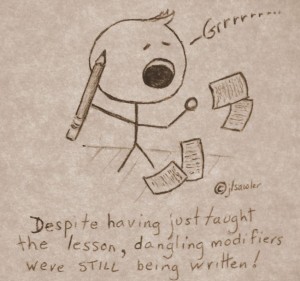Guest post by Cathy Witlox

© JL Sawler www.WriteOrReviseDaily.wordpress.com
Most people assume that if you’re a writer, you know grammar. But the truth is, many really talented writers have poor grammar, though they may not even realize it. After all, as a friend of mine has often said, people just don’t know what they don’t know.
As a writer, you are probably aware of such common errors as mistaking its for it’s and affect for effect and work hard to rid your stories of them. And that’s a good thing. A manuscript littered with these sorts of booboos can drive an editor crazy — crazy enough in some cases to reject your submission altogether.
Other errors are tougher to find but just as important to avoid. After all, you don’t want careless mistakes to distract an editor from the rest of your beautiful prose!
Below I offer tips on identifying and fixing three common errors that even experienced writers can miss.
1. Don’t Dangle Your Modifiers
Dangling modifiers usually fall at the beginning of a sentence. Grammatically, a modifier (descriptive phrase) that begins a sentence must refer to the subject of the sentence. In the sentence “At age eight, my parents bought me a dirt bike,” the parents were eight years old when they made this dirt-bike purchase. This sentence is nonsensical and would bother any good editor.
Here’s one I read recently in a published article: “Created by a team of NASA scientists, GM wants to use the lightweight plastic in its cars.” Although the reader can surmise that it was the lightweight plastic that was created by the scientists, the sentence actually says that the NASA scientists created GM.
Catching danglers in your own writing is tough because of course you understand what you meant to say. But a dangling modifier is always a phrase (that is, it never contains a subject/verb combination), so take time to read over your opening phrases; ask yourself whether what follows is the thing that the phrase describes.
For example, in the second paragraph of this article, I began a sentence with the phrase As a writer and immediately followed it with you, which is correct. But if I had written “As a writer, fixing such common errors as its for it’s and affect for effect may come naturally to you,” would you have noticed the error? As a copy editor, my eye would twitch severely (making it difficult to continue reading)!
2. Avoid Pronoun Shifts
When I began reading Keith Richards’s memoir, I wasn’t expecting a literary masterpiece. Nevertheless, I was irked by his pronoun shifts and, on several occasions, found myself cursing his copy editor. A sudden and inappropriate change of perspective pushes you right out of the story.
Here are a couple examples from Life:
The main effect of the war on me was just that phrase, “Before the War.” Because you’d hear grown-ups talking about it. “Oh it wasn’t like this before the war.” Otherwise I wasn’t particularly affected. (p. 22)
Some of [the songs] had us on our knees. Some are about thirty-five years old and I’ve not quite finished them yet. You can write the song, but that’s not the whole deal. (p. 309)
Do those shifts from the I perspective to you bother you? Like me, many editors wouldn’t appreciate such shiftiness. (Pronoun shifts from the singular it to the plural they are even more common than ones from first person I to second person you, so watch for those too.)
3. Rein in Run-on Sentences
Contrary to popular belief (even among writers), a run-on sentence is not an extraordinarily long sentence. It is a grammatical error, not a stylistic one.
A run-on consists of two or more independent clauses incorrectly joined by a comma (creating a “comma splice”) or no punctuation at all (creating a “fused sentence”). Run-on sentences are particularly hard to spot when reading quickly, so slow down to catch these.
A famous run-on sentence is “I came, I saw, I conquered.” Each of these three short clauses is a complete grammatical sentence. To avoid the comma splices, the punctuation should be as follows: “I came. I saw. I conquered.” In this case, most editors wouldn’t take issue with a writer making a stylistic choice to use commas, in part because periods would change the rhythm. But it’s important to know the rule, even if occasionally in your writing you make a reasoned decision to break it.
Here are some examples of more common, and much uglier, run-ons:
Joe couldn’t drive his car, it had a flat tire.
The baby is doing well she even sleeps through the night.
Please put the can in the blue bin, it’s recyclable.
Once you identify a sentence as a run-on, you can fix it by adding a period or a semicolon or by making one of the independent clauses dependent. The above sentences can be fixed like so:
Joe couldn’t drive his car because it had a flat tire.
The baby is doing well; she even sleeps through the night.
Please put the can in the blue bin. It’s recyclable.
Put Your Grammar to the Test
It’s true that an editor judging a literary competition or one acquiring manuscripts for a publisher will largely focus on literary aspects of your story such as characters, plot, and pacing. But by cleaning up your grammar, you avoid diverting the editor’s attention from the strengths of your work.
Over to you. Can you find the dangling modifier, the pronoun shift, and the run-on sentence I intentionally slipped into this post? Happy editing!
(Answers are at the bottom of the page, don’t peek.)
* * *
 CATHY WITLOX works full-time as a freelance copy editor and part-time as an instructor of grammar and copy editing courses at the University of Toronto School of Continuing Studies and Ryerson University. Her editing career began in-house at Harlequin Enterprises, where she also wrote grammar articles for the website, attracting an audience across three continents. Cathy launched her freelance editing business, WordWitlox, in 2004. She now edits for a variety of publishers and corporations. When not editing or teaching, Cathy spends much of her time walking and training her three dogs or blogging about them.
CATHY WITLOX works full-time as a freelance copy editor and part-time as an instructor of grammar and copy editing courses at the University of Toronto School of Continuing Studies and Ryerson University. Her editing career began in-house at Harlequin Enterprises, where she also wrote grammar articles for the website, attracting an audience across three continents. Cathy launched her freelance editing business, WordWitlox, in 2004. She now edits for a variety of publishers and corporations. When not editing or teaching, Cathy spends much of her time walking and training her three dogs or blogging about them.
Grammar errors in this post:
A. Dangling modifier: As a copy editor, my eye would twitch severely (making continuing to read quite a chore!).
B. Pronoun shift: Nevertheless, I was irked by his pronoun shifts and, on several occasions, found myself cursing his copy editor. A sudden and inappropriate change of perspective pushes you right out of the story.
C. Run-on sentence: Answers are at the bottom of the page, don’t peek.
Potential fixes:
A. As a copy editor, I would have to overcome a severe eye twitch before I could continue reading!
B. The sudden and inappropriate change of perspective pushed me right out of the story.
C. Answers are at the bottom of the page, but don’t peek.
Valuable Grammar Resources
Wonderful guest post, Cathy! You explain everything so clearly. I especially love the added errors.
I read the post carefully and still wasn’t able to spot the errors. This is why good editors are priceless! (Fantastic post.)
As usual, Cathy, your insightful blog comes with equal measures of intelligence and good humour. Fortunate are the students who wind up in your courses!
Thanks, all, for the kind words! It was fun to be a guest on Allyson’s wonderful blog! And it was surprisingly fun to include three grammatically incorrect sentences!
Wonderful post, Cathy! As always, you combine the voice of authority with a friendly tone. What an excellent teacher you are!